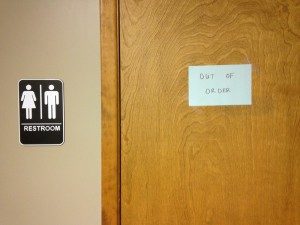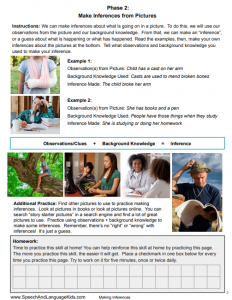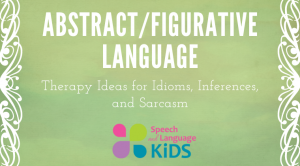How to Help Children Learn to Make Inferences
An inference is when you use clues present (in text or in real life) along with your background knowledge to make a guess about something that’s not explicitly known.
For example, if you see an “out of order” sign, you can use that clue and combine it with your background knowledge that “out of order” means something is broken. You can then make an inference that the toilet or sink is broken in that bathroom. This can be a tricky skill for our children with language delays to learn. Here are our resources for teaching this skill.
Listen to the Podcast of this Info:
How to Teach a Child to Make Inferences:
Clues from Text or Pictures + Background Knowledge = Assumption of what has happened or what is happening
Let me give you an example. You walk up to the bathroom and see this:

From this text, you gather the clue that someone has placed an “out of order” sign on the bathroom door. You combine this with your background knowledge that “out of order” means something typically isn’t working and the main working part of a bathroom is the toilet. Using these two parts, you can reasonably assume that the toilet is not working and they therefore do not want anyone to use it. That, my friend, is an inference.
What Do We Use Inferences For?
Inferences come in handy frequently throughout our day. Not only do we make inferences about text that we are reading, we also using inferences to “read” our environment and make inferences about what’s going on around us. Also, we use inferences to “read” other people and try to make assumptions on what they’re thinking or feeling so we can adjust our actions accordingly.
Inference Vs. Prediction
Keep in mind that inferences are made about past events or events that are currently happening. If you make an assumption or guess on what is about to happen (something in the future), you’re actually making a prediction, not an inference.
When to Work on Inferences (Common Core State Standards)?
Our students with language delays often have trouble with inferencing because it requires them to use language at a higher level than the straight-forward way that they are used to. For that reason, making inferences can be a great target for speech therapy sessions or home practice.
So when is it appropriate to work on these skills? When should we assume to see them in our students? Great question! Since most of the United States are adopting the Common Core Curriculum State Standards, I am going to use their guidelines for when and how children should be using inferences.
Here’s what the common core says children should be able to do in the different grades:
Grade 4 (Reading Standard): Refer to details and examples in a text when explaining what the text says explicitly and when drawing inferences from the text.
Simply Stated: Read a text, tell you what inference they drew from it, and then circle or underline the words that helped them make that inference
Grade 5 (Reading Standard): Quote accurately from a text when explaining what the text says explicitly and when drawing inferences from the text.
Simply Stated: Read a text, tell you what inference they drew from it, and speak or write the sentence(s) that helped them make that inference
Grade 6 (Reading Standard): Cite textual evidence to support analysis of what the text says explicitly as well as inferences drawn from the text.
Simply Stated: Read a text, tell you what inference they drew from it, and summarize what information from the text helped them make that inference
Grade 7 (Reading Standard): Cite several pieces of textual evidence to support analysis of what the text says explicitly as well as inferences drawn from the text.
Simply Stated: Read a text, tell you what inference they drew from it, summarize several points that helped them make that inference
Grade 8 (Reading Standard): Reading Grade 8: Cite the textual evidence that most strongly supports an analysis of what the text says explicitly as well as inferences drawn from the text.
Simply Stated: Read a text, tell you what inference they drew from it, summarize the points from the text that were the most helpful to making that inference (prioritize out the most important)
Grades 9-10 (Reading Standard): Cite strong and thorough textual evidence to support analysis of what the text says explicitly as well as inferences drawn from the text.
Simply Stated: Read a text, tell you what inference they drew from it, summarize the points from the text that were the most helpful to making that inference and as many points as are necessary to thoroughly demonstrate the basis for that inference
Grades 11-12 (Reading Standard): Cite strong and thorough textual evidence to support analysis of what the text says explicitly as well as inferences drawn from the text, including determining where the text leaves matters uncertain.
Simply Stated: Same as 9-10 but include information about where the text doesn’t provide enough information to fully support the inference
Sample IEP Goals for Making Inferences
So what exactly will we be teaching and measuring then? You’ll need to look at the common core standards (or whatever standards your school goes by) and then look at how well the student can currently perform the skill. Write a goal that will get as close as possible to the target skill with added supports as needed. Here are a few examples to get you started (Click Here if you need help with writing goals).
Sample Goals:
By the end of the IEP cycle, CHILD will read a grade-level text (informational or literature) and make one inference from the text on 4 of 5 opportunities in the speech therapy setting with one reminder of the definition of an inference as needed.
By the end of the IEP cycle, after making an inference about a grade-level text (or being helped to find one if needed), CHILD will underline the pieces of the text that gave clues to the inference on 4 of 5 observed opportunities with one verbal hint from the therapist as needed during a speech therapy session.
Step One: Making Inferences from Pictures
Since it is typically easier to make an inference from a picture than from a text, we’ll start with that. Have the child look at a picture. You can find pictures in books that are good for inferencing or download my worksheets of 12 pictures for making inferences by clicking the button below:
If you are using your own pictures, try to take pictures of things that are out of place or pictures that clearly define an event that just happened.
How to Teach It:
Take each picture and show it to the child. Ask the child to guess what is going on in the picture or what happened before the picture was taken. Then, talk to the child about what an inference is. You can say something like “an inference is when we find clues in the picture and combine them with our own background knowledge to make an assumption about what is happening or what just happened”.
Then, show the child the picture again and talk through the inference that was made. For example, in the bathroom example above, you would explain to the child that the inference is that the toilet is broken. You figured that out because you used the clues from the picture (out of order sign) and combined that with your background knowledge that “out of order” means broken and the toilet is the main working part of the bathroom.
Walk the child through several examples like that until the child can identify the two pieces that contribute to the inference on his or her own.
Step Two: Making Inferences from Text and Pictures Combined
Since it can be quite the jump from making inferences about pictures to inferences about text only, I like to include an in between step where they make inferences about text and pictures combined. You can use children’s books that have a simple story along with pictures or something like a comic strip that uses text within a picture. Comic strips (like from your Sunday Funnies section of the newspaper) can be very good because they rely heavily on inferences to make the strips funny.
Take this comic strip for example:

Observations/Clues: The pets are running around like crazy. The owner says he wished he had the receipt for the pets.
Background Knowledge: You need the receipt when you return something that you don’t want anymore.
Inference: The owner wishes he could take back his pets sometimes.
How To Teach It:
For this step, read the text and look at the pictures with the child. Then, have them make an inference and back it up by telling you what in the text or pictures they used as clues/observations and what background knowledge they had to add to come up with their assumption.
Step Three: Making Inferences about Text
Finally! We’ve made it to the actual skill that kids are expected to use in school. These children must read a grade level text (literature and informational) and then make inferences based on the information provided. The child you’re working with may not be ready for something on grade level yet so you may have to adapt this skill down at first. Start with steps one and two from this tutorial before you go into this step because you want them to have a good working knowledge of what an inference is and how to come up with one.
How to Teach It:
Show the child a few sentences that are written down that could lead to an inference. Ask the child to read the text and then make an inference about what just happened or what is currently happening. Once the child has made his inference, have him circle or underline the parts of the sentence that he used for clues/observations and then have him write down what background knowledge he added to come up with his inference.
For example, here is the sentence:
“Johnny walked into the room and saw a birthday cake with his name on it, presents, and all of his friends standing around the table”.
Inference: It is Johnny’s birthday.
Observations/Clues:
“Johnny walked into the room and saw a birthday cake with his name on it, presents, and all of his friends standing around the table”.
Background Knowledge: You get presents and a birthday cake with your name on it when it’s your birthday.
Once you have done several examples like this and the child is able to come up with an inference and tell you how he got there, you’re ready to gradually increase the difficulty level of the text. Work your way up to being able to do this in the readings or texts that the child has been assigned for his classes. Provide support for the child by walking him through the steps of picking out the clues and adding background knowledge as needed.
Using Inferences for Social Skills
If you are working with a child who purely needs to use inferencing for reading activities, you can stop here. However, many children with social problems also need help with making inferences in social situations. If a child doesn’t understand how to “read” a situation to figure out how to act or “read” a person’s body language to get a good idea of what’s going on, they may need some inferencing help.
Children who have trouble with this skill are often having difficulty with both parts of the formula. Let’s look at an example.
Johnny starts talking to Fred about trains. Johnny loves trains so he tells Fred everything that he knows about trains. He has been talking about trains for 5 minutes. Fred starts to look at his watch and tap his foot. He starts looking around and he stops responding to what Johnny is saying. Johnny keeps talking anyway.
Know anyone like that?
Well, poor Johnny has a few problems here. Chances are, he doesn’t notice that Fred looks disinterested. He hasn’t noticed him looking at his watch or tapping his foot. Furthermore, Johnny doesn’t even know that those signs typically mean that someone is not interested. So even if Johnny had noticed Fred looking around, he doesn’t have the background knowledge to tell him that when someone starts looking around, they aren’t interested in what you’re saying.
How to Teach It:
In order to teach making inferences for social skills, you need to teach the child not only to start paying attention and making observations, but also to know what to look for. You must give the child the background knowledge necessary to know what nonverbal behaviors mean.
Start by choosing one social skill that the child has trouble with, like knowing when someone is no longer interested in what he has to say. Teach the child what to look for (what observations or clues to look for) and then teach him what those clues mean. Role play situations where you demonstrate the clues for the child and the child has to recognize them. Then, you’ll also need to teach the child what to do when he notices those signs, like ask the other person a question about himself or herself.
Practice those situations and then take the child to a situation where those kinds of things may happen and signal him to pay attention to the clues when you see them arise. You can also video tape interactions and play them back to the child to help him see the clues when they arise.
Free Inferencing Worksheets:
Don’t forget to download my free inferencing worksheets with 12 different pictures for you to make inferences about along with places to write out your observations and your background knowledge. Click the button below to download!

About the Author: Carrie Clark, MA CCC-SLP
Hi, I’m Carrie! I’m a speech-language pathologist from Columbia, Missouri, USA. I’ve worked with children and teenagers of all ages in schools, preschools, and even my own private practice. I love digging through the research on speech and language topics and breaking it down into step-by-step plans for my followers.
Fun Fact: I play the cello. I took lessons for cello and piano for most of my childhood, though I’m way better at cello than I ever got a piano. I also taught myself guitar as an adult. I have a super fun bright blue electric guitar that I get out every once in a while and play around on. And then I curse the fact that since I don’t play consistently, I don’t have my callouses built up.
Connect with Me:
Podcast: Play in new window | Download | Embed
Subscribe: RSS










Wow, this is perfect ! Thank you so much for putting this together.
You’re welcome!
Thank u very much,you are doing something great regarding our career,I mean to take out all the dust from the classical boring old goals,that’s it , goals should represents the child daily activities.you know that,in some stage of stuttering treatment am asking my clients to tel jokes , first me and him alone in the session room,thenn to other staff in the reception area, I like those functional goals.
Dr.jihad almasri
You are welcome! I love using functional goals as well!
Very timely, I have a couple of students in third grade that are having difficulty with fact and opinion as well as abstract thinking skills.
Another student that I am struggling with has difficulty with auditory processing where he has troubling holding 3 clues in his working memory and work out what the answer is. Any suggestions. I think I am going to start with a limited field of choices and then fade this.
He also has difficulty playing games like Guess Who where he asks questions and then eliminate the items that do not qualify.
Hello! I’m glad you enjoyed my content. I am actually planning to do a webinar on auditory processing soon as it has been a very commonly asked-for topic. I plan on having a webinar this month or next for the members of my membership site. Keep an eye out on my social media sites or join my mailing list to be notified when that webinar is coming up!
When I click on “download” nothing will come up and the screen gets darker with a grey overlay
THanks!
It sounds like your network is blocking my download box. I’ll email it to you directly!
I can’t tell you how happy I am to find this! It’s exactly what I need to validate my approach and reinforce/guide me. Thank you so much.
So glad to hear that, Terri! Thanks for letting us know!
Does it matter if the child reads the text or I read a scenario to them? We are working on reading comprehension also but I wanted to take poor vocabulary skills and below grade level reading problems out of the equation.
Do you offering continuing education units for teaching inferencing?
Hi, Tresie-Unfortunately, we do not have a webinar that teaches inferencing. However, I do love the suggestion and will add it to our list for consideration for an upcoming webinar.